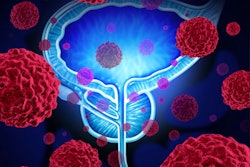
Radiology accounted for $2.1 billion in spending for cancer care services in 2018, the second most expensive line item in a new study of over 402,000 people with cancer that was published October 6 in JAMA Network Open.
That was one of several findings from a team led by Dr. Nicholas Zaorsky from Penn State University on cancer care costs for privately insured adults in the U.S., including imaging and radiation therapy. Medical supplies and nonphysician services, meanwhile, contributed the most to spending at $4 billion.
"The high cost shows that radiology is an underappreciated component of the care continuum that drives part of the high cost of cancer care," Zaorsky told AuntMinnie.com.
Cancer care spending in the U.S. for those older than 65 with Medicare was estimated to be $125 billion in 2010 and is set to increase to $158 billion in 2020. National spending for cancer care is substantial and expected to increase because of population changes alone, but the expenses that contribute to these figures are poorly understood, the researchers said.
"To our knowledge, there is limited data regarding population estimates of resources and spending on cancer care in the U.S. for patients with private insurance," the study authors wrote.
The researchers wanted to characterize the most frequent medical services provided for privately insured cancer patients in the U.S. and the costs associated with these services, with the goal of identifying potential targets for decreasing resource consumption.
Procedures were divided into the following categories: anesthesia, surgery, radiology, pathology and laboratory, evaluation and management, medical services, and coding systems.
The study authors looked at 2018 data from 402,115 patients and found the cost of cancer care for the 15 most prevalent cancer types to be about $156.2 billion for privately insured adults younger than 65 in the U.S.
A total of 38.4 million documented procedure codes for 15 cancers were found, totaling $10.8 billion. Patients with breast cancer contributed the greatest total number of services at 10.9 million (28.4%), followed by those with colorectal cancer at 3.9 million (10.2%) and prostate cancer at 3.6 million (9.4%).
Breast cancer was found to be the costliest cancer type at $3.4 billion, followed by lung cancer ($1.1 billion) and colorectal cancer ($1.1 billion).
For the radiology category, several services were included, such as CT, screening mammography, radiotherapy, and MRI, among others. Radiology was found to be the second-largest contributor to cancer care costs, after medical supplies and nonphysician services.
| Costs of cancer care in 2018 by type of medical service | ||
| Type of service | Cost | Percentage of total spending |
| Medical supplies and nonphysician services | $4 billion | 37% |
| Radiology | $2.1 billion | 19.4% |
| Surgery | $1.8 billion | 16.7% |
Radiological procedures in the study, meanwhile, ranged from 280,000 to 350,000. The most commonly performed procedure was abdominal or pelvic CT scan with contrast material, while the least commonly performed was intensity-modulated radiation treatment delivery (complex).
Zaorsky told AuntMinnie.com the study highlights cancer being a major contributor to the high cost of private health insurance in the U.S.
"Any time costs go up, insurers inevitably pass along these costs to consumers in the form of higher premiums and/or higher rates of cost-sharing," he said. "So, it is important for policymakers and consumers to think about whether this is the best way to spend limited health care resources."
The team wrote that further research is needed to better identify and target wasteful procedures. Zaorsky said the team will evaluate the costs borne by patients and their families.



















